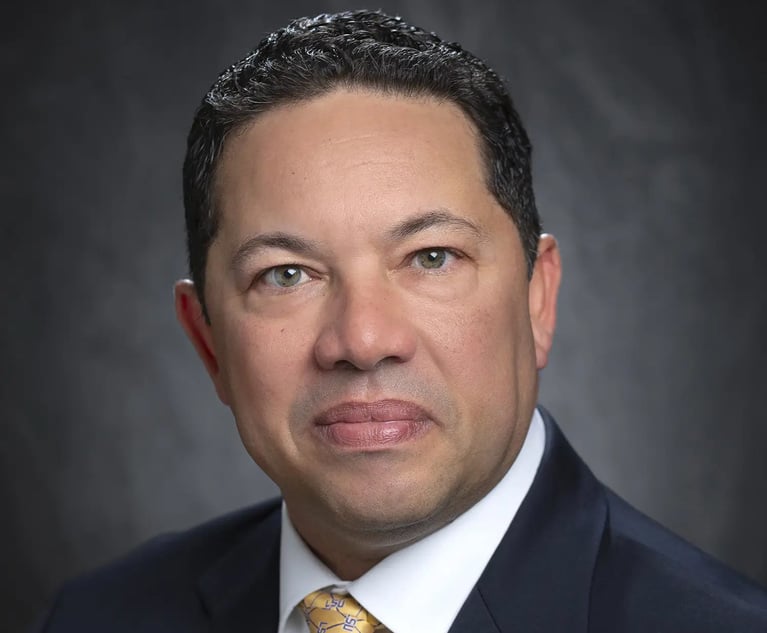Connecting the right future GC to holistic risk management needs
Review of the demographics of general counsel within the Fortune 500 indicates a compelling mandate for a strategic approach to the inevitable.
February 23, 2014 at 07:00 PM
7 minute read
Review of the demographics of general counsel within the Fortune 500 foreshadows the transition that approximately 25 percent of these companies are facing in the next few years and indicates a compelling mandate for a strategic approach to the inevitable.
Succession strategies that provide smooth transitions in key leadership roles are an essential aspect of a company's risk management profile. For the general counsel role, which carries with it the mandate for holistic risk management across an enterprise, succession planning should be a high priority. How companies address mitigating gaps in key leadership roles, and retain and develop talent, impacts investor confidence and may impact rating agency evaluations and even regulatory harmony.
In a recent benchmarking survey conducted by the Conference Board, 44 percent of companies reported that developing top talent to support their organizational goals was the greatest challenge they would face in the next 12 months.
Most organizations today still approach succession in the GC role in a less than strategic manner. In many cases, it has been ad hoc and “as needed” replacement planning. In other cases, it has been more granular, focused on developing particular individuals, or hiring “ready now” candidates for potential future roles (a challenge in itself). However, none of these approaches mitigate the organizational impact of a key gap resulting from the absence of planning. Such impact includes loss of “blocked” talent, or selection based on past track record. This does not necessarily foretell capability for handling the company's goals and challenges ahead as a leader.
The approach
Recognizing why GC succession planning is so critical leads us to the question of how to proceed, particularly for companies without a systemic organizational approach, which may be far behind processes employing the scientifically validated tools available today. A true succession process goes beyond the identification of a replacement. It extends across and into the fabric of the organization to identify those leaders who are judged to be ready, ready soon or have high potential that can be developed for future leadership roles.
“Best-in-class” succession management will not be uniform from company to company. The variations in business size, geographic scale, future goals of the company, and the size of the legal function all affect the process. Companies that lack internal resources to maintain such processes can rely on consultants for the process and the assessment. However, the overarching mandate is to look beyond the “ready” talent and delve into the roles and levels below, planning for the future. Approaching the “ready now,” “ready soon” and “those to watch” with different action plans is a hallmark of an effective succession program. Another tenet of an effective program is “buy-in”—the investment of key stakeholders—to ensure succession data is fresh, updated and relevant.
Building the framework
While approaches and tools may vary, a succession framework requires certain questions be asked in order to set the plan in motion. Firstly, the framework requires alignment on the need for such plans and programs, which means agreement that the GC is a key leader.
Secondly, there must be agreement about the company's goals, as well as the cultural core values that govern how to attain those goals. Such accord will help define which characteristics and traits are essential for success in the GC role in that particular company.
Thirdly, a useful succession framework includes a process to identify an internal pipeline or “bench” of talent. The identification will require assessment of “ready now,” “ready soon” and “high-potential” talent, their strengths and weaknesses as leaders, as well as any substantive gaps in practical experience. Development plans should then be created to shore up the skills and characteristics needed for the GC role in the particular company.
Review of the demographics of general counsel within the Fortune 500 foreshadows the transition that approximately 25 percent of these companies are facing in the next few years and indicates a compelling mandate for a strategic approach to the inevitable.
Succession strategies that provide smooth transitions in key leadership roles are an essential aspect of a company's risk management profile. For the general counsel role, which carries with it the mandate for holistic risk management across an enterprise, succession planning should be a high priority. How companies address mitigating gaps in key leadership roles, and retain and develop talent, impacts investor confidence and may impact rating agency evaluations and even regulatory harmony.
In a recent benchmarking survey conducted by the Conference Board, 44 percent of companies reported that developing top talent to support their organizational goals was the greatest challenge they would face in the next 12 months.
Most organizations today still approach succession in the GC role in a less than strategic manner. In many cases, it has been ad hoc and “as needed” replacement planning. In other cases, it has been more granular, focused on developing particular individuals, or hiring “ready now” candidates for potential future roles (a challenge in itself). However, none of these approaches mitigate the organizational impact of a key gap resulting from the absence of planning. Such impact includes loss of “blocked” talent, or selection based on past track record. This does not necessarily foretell capability for handling the company's goals and challenges ahead as a leader.
The approach
Recognizing why GC succession planning is so critical leads us to the question of how to proceed, particularly for companies without a systemic organizational approach, which may be far behind processes employing the scientifically validated tools available today. A true succession process goes beyond the identification of a replacement. It extends across and into the fabric of the organization to identify those leaders who are judged to be ready, ready soon or have high potential that can be developed for future leadership roles.
“Best-in-class” succession management will not be uniform from company to company. The variations in business size, geographic scale, future goals of the company, and the size of the legal function all affect the process. Companies that lack internal resources to maintain such processes can rely on consultants for the process and the assessment. However, the overarching mandate is to look beyond the “ready” talent and delve into the roles and levels below, planning for the future. Approaching the “ready now,” “ready soon” and “those to watch” with different action plans is a hallmark of an effective succession program. Another tenet of an effective program is “buy-in”—the investment of key stakeholders—to ensure succession data is fresh, updated and relevant.
Building the framework
While approaches and tools may vary, a succession framework requires certain questions be asked in order to set the plan in motion. Firstly, the framework requires alignment on the need for such plans and programs, which means agreement that the GC is a key leader.
Secondly, there must be agreement about the company's goals, as well as the cultural core values that govern how to attain those goals. Such accord will help define which characteristics and traits are essential for success in the GC role in that particular company.
Thirdly, a useful succession framework includes a process to identify an internal pipeline or “bench” of talent. The identification will require assessment of “ready now,” “ready soon” and “high-potential” talent, their strengths and weaknesses as leaders, as well as any substantive gaps in practical experience. Development plans should then be created to shore up the skills and characteristics needed for the GC role in the particular company.
This content has been archived. It is available through our partners, LexisNexis® and Bloomberg Law.
To view this content, please continue to their sites.
Not a Lexis Subscriber?
Subscribe Now
Not a Bloomberg Law Subscriber?
Subscribe Now
NOT FOR REPRINT
© 2025 ALM Global, LLC, All Rights Reserved. Request academic re-use from www.copyright.com. All other uses, submit a request to [email protected]. For more information visit Asset & Logo Licensing.
You Might Like
View All

Fired by Trump, EEOC's First Blind GC Lands at Nonprofit Targeting Abuses of Power
3 minute read
LSU General Counsel Quits Amid Fracas Over First Amendment Rights of Law Professor
7 minute read
Keys to Maximizing Efficiency (and Vibes) When Navigating International Trade Compliance Crosschecks
6 minute readTrending Stories
- 1Google Makes Appeal to Overturn Jury Verdict Branding the Play Store as an Illegal Monopoly
- 2First Amendment Litigator Returns to Gibson Dunn
- 3In Record Year for Baker Botts, Revenue Up 11.8%, PEP Up 17.6%
- 4Loopholes, DNA Collection and Tech: Does Your Consent as a User of a Genealogy Website Override Another Person’s Fourth Amendment Right?
- 5Free Microsoft Browser Extension Is Costing Content Creators, Class Action Claims
Who Got The Work
J. Brugh Lower of Gibbons has entered an appearance for industrial equipment supplier Devco Corporation in a pending trademark infringement lawsuit. The suit, accusing the defendant of selling knock-off Graco products, was filed Dec. 18 in New Jersey District Court by Rivkin Radler on behalf of Graco Inc. and Graco Minnesota. The case, assigned to U.S. District Judge Zahid N. Quraishi, is 3:24-cv-11294, Graco Inc. et al v. Devco Corporation.
Who Got The Work
Rebecca Maller-Stein and Kent A. Yalowitz of Arnold & Porter Kaye Scholer have entered their appearances for Hanaco Venture Capital and its executives, Lior Prosor and David Frankel, in a pending securities lawsuit. The action, filed on Dec. 24 in New York Southern District Court by Zell, Aron & Co. on behalf of Goldeneye Advisors, accuses the defendants of negligently and fraudulently managing the plaintiff's $1 million investment. The case, assigned to U.S. District Judge Vernon S. Broderick, is 1:24-cv-09918, Goldeneye Advisors, LLC v. Hanaco Venture Capital, Ltd. et al.
Who Got The Work
Attorneys from A&O Shearman has stepped in as defense counsel for Toronto-Dominion Bank and other defendants in a pending securities class action. The suit, filed Dec. 11 in New York Southern District Court by Bleichmar Fonti & Auld, accuses the defendants of concealing the bank's 'pervasive' deficiencies in regards to its compliance with the Bank Secrecy Act and the quality of its anti-money laundering controls. The case, assigned to U.S. District Judge Arun Subramanian, is 1:24-cv-09445, Gonzalez v. The Toronto-Dominion Bank et al.
Who Got The Work
Crown Castle International, a Pennsylvania company providing shared communications infrastructure, has turned to Luke D. Wolf of Gordon Rees Scully Mansukhani to fend off a pending breach-of-contract lawsuit. The court action, filed Nov. 25 in Michigan Eastern District Court by Hooper Hathaway PC on behalf of The Town Residences LLC, accuses Crown Castle of failing to transfer approximately $30,000 in utility payments from T-Mobile in breach of a roof-top lease and assignment agreement. The case, assigned to U.S. District Judge Susan K. Declercq, is 2:24-cv-13131, The Town Residences LLC v. T-Mobile US, Inc. et al.
Who Got The Work
Wilfred P. Coronato and Daniel M. Schwartz of McCarter & English have stepped in as defense counsel to Electrolux Home Products Inc. in a pending product liability lawsuit. The court action, filed Nov. 26 in New York Eastern District Court by Poulos Lopiccolo PC and Nagel Rice LLP on behalf of David Stern, alleges that the defendant's refrigerators’ drawers and shelving repeatedly break and fall apart within months after purchase. The case, assigned to U.S. District Judge Joan M. Azrack, is 2:24-cv-08204, Stern v. Electrolux Home Products, Inc.
Featured Firms
Law Offices of Gary Martin Hays & Associates, P.C.
(470) 294-1674
Law Offices of Mark E. Salomone
(857) 444-6468
Smith & Hassler
(713) 739-1250






